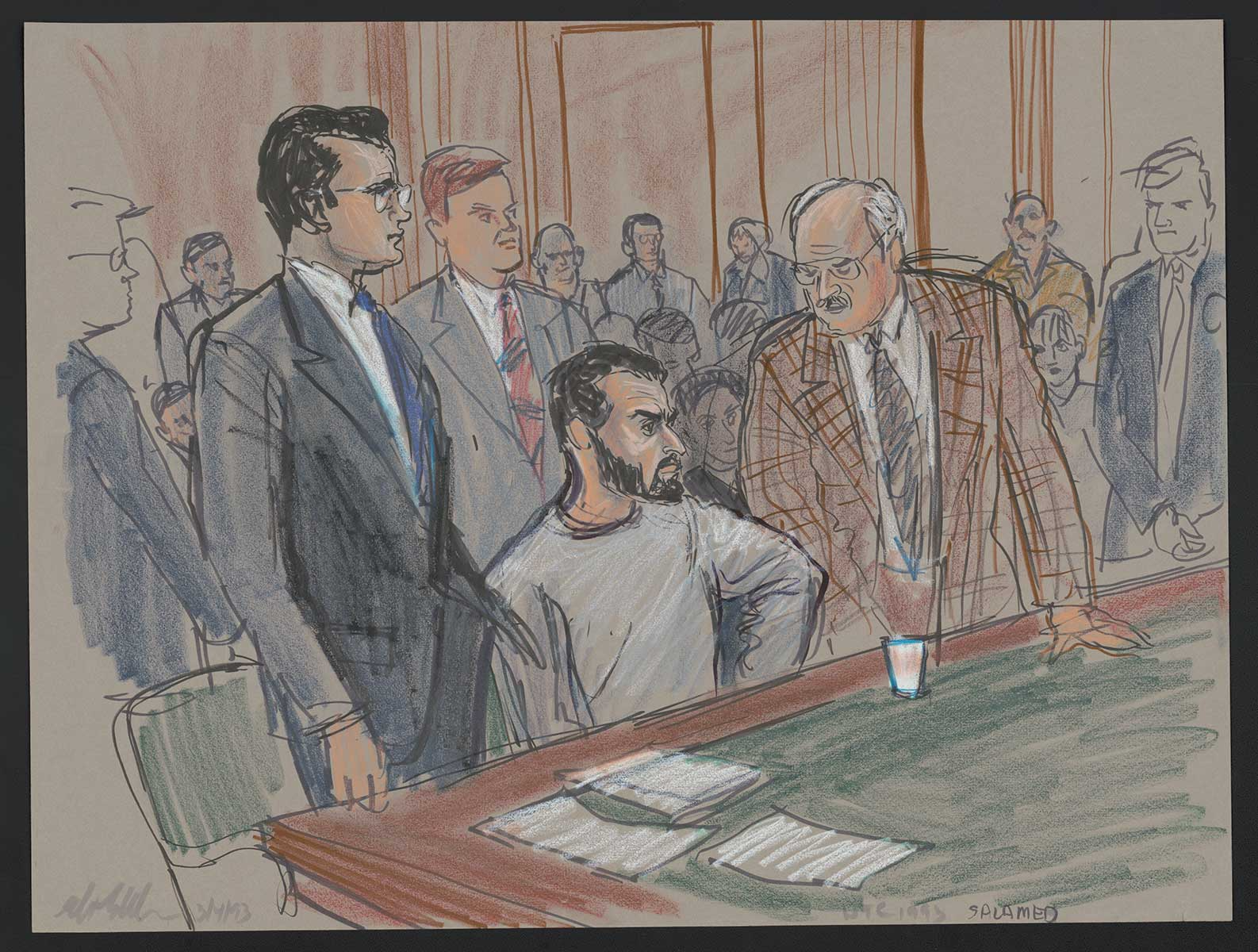Thirty Years after the First World Trade Center Bombing
Sunday marked the 30th anniversary of the first World Trade Center bombing, masterminded by Ramzi Yousef — an illegal alien stopped at JFK when he tried to enter without documents (and the documents he did have were fraudulent), only to be released for lack of detention space after making a bogus asylum claim. If that sounds familiar, it did to a Republican congressman, too, who asked DHS Secretary Alejandro Mayorkas what he was doing to stop future terrorists from doing the same thing — an answer Mayorkas shamefully ducked and then blithely ignored.
The First World Trade Center Bombing. Thirty years is a long time, and most millennials are likely unaware that there even was a World Trade Center bombing prior to the destruction of the Twin Towers on September 11, 2001. The two attacks are linked by more than target and location.
Just after noon on February 26, 1993, a van parked in a garage under the north tower carrying 1,200 pounds of explosives detonated, creating a 20,000 square foot crater about seven stories deep. Six died nearly instantly, including an expectant mother, and more than a thousand were injured. As the FBI explained: “Middle Eastern terrorism had arrived on American soil — with a bang.”
Yousef and six associates carried it out, and the ringleader later asserted that the plan was to topple the one tower on top of the other.
As the 9/11 Commission Report explained: “Yousef’s instant notoriety as the mastermind of the 1993 World Trade Center bombing inspired” his uncle, Khalid Sheikh Mohammed (KSM), “to become involved in planning attacks against the United States.” The biggest of those KSM attacks, of course, was 9/11 itself, where the uncle succeeded where the nephew had failed.
The Investigation. The conspirators initially escaped, but the FBI and the New York Joint Terrorism Task force quickly commenced a large-scale investigation. Digging through the rubble, they found what would turn out to be a key piece of evidence: the vehicle identification number from the van that had carried the bomb.
A quick search revealed the van had been rented and reported stolen the day before the bombing, and when Mohammad Salameh, who had rented the van, went to get his $400 deposit back six days later, the FBI quickly arrested him.
Shortly thereafter, Salameh’s fellow co-conspirators Nidal Ayyad, Mahmoud Abouhalima, and Ahmed Ajaj were also taken into custody.
Yousef, however, fled the United States to Pakistan the day of the bombing, using a Pakistani passport issued under the name “Abdul Basit Karim”. It wasn’t the first time that he had traveled under a different identity.
Ramzi Yousef. According to the 9/11 Commission, Yousef’s real name actually is “Abdul Basit”, and he was born in Kuwait to Pakistani and Palestinian parents.
He left home to study electrical engineering in the United Kingdom, and returned to Kuwait before fleeing in the wake of the Iraqi invasion of the country in 1990. He eventually made his way to Afghanistan, where he studied bomb-making techniques at a terrorist camp in Khalden, finishing up just before the February 1993 attack.
With Yousef at Khalden was Ajaj, a Palestinian refugee. On September 1, 1992, the duo flew under aliases from Karachi, Pakistan, to John F. Kennedy Airport (JFK) in New York on Pakistani International Airlines Flight 703.
Yousef and Ajaj were poster children for a key point in the 9/11 Commission staff report on terrorist travel: “Once terrorists had entered the United States, their next challenge was to find a way to remain here. Their primary method was immigration fraud.” For the pair, that meant asylum fraud.
Once they landed at JFK, each headed to a different INS inspection kiosk. Yousef presented himself to an inspector named Martha Morales, handing her a boarding pass in the name of “Mohammed Azan” and an Iraqi passport.
The passport lacked the entry visa Yousef would have needed for admission, and so he told Morales “he was fleeing the oppressive regime of Saddam Hussein and needed asylum.” Morales took Yousef to secondary inspection, where he spoke to the inspector in “excellent English with a British accent”.
Yousef claimed he had paid a corrupt Pakistani official for the boarding pass (a common claim in airport asylum cases), and that “he had recently been beaten by Iraqi soldiers when he was in Kuwait because they thought he was a member of a Kuwaiti guerrilla organization” — a story the 9/11 staff described as “bogus”.
Upon searching Yousef’s belongings, Morales found “an identity card from an Islamic organization in Arizona, along with checks from Lloyd’s Bank of London and an address book listing what Morales would later call ‘unusual places [in the United States] for someone to visit whom had just come from halfway around the world.’”
Morales charged Yousef with excludability for attempting to make an illegal entry into the United States. Then and now, inadmissible arriving aliens are supposed to be detained pending a hearing. In Yousef’s case, that meant detention pending an exclusion proceeding before an immigration judge to determine whether he was admissible and, if not admissible, eligible for asylum.
The inspector recommended Yousef be detained, believing that “he might pose a danger to the United States”. That recommendation was overruled because “the INS Detention Center was full”.
If that rings a bell, it’s because it’s the same excuse the Biden administration has used to release more than 1.8 million illegal migrants apprehended by Border Patrol agents into the United States. Hold that thought.
Yousef was released on his own recognizance, and though he claimed he was headed to Houston, Texas, he instead caught a cab from the airport “to the al-Farooq mosque where he met up with Abouhalima”, who subsequently helped him get a driver’s license that he used as identification. At that point, the plot was in motion.
Ajaj, the bomb expert, wasn’t so lucky. His INS inspector, Robert Malafronte, concluded the Swedish passport he had presented had a photo-substituted identification page.
When Ajaj was sent for additional questioning, inspectors found numerous different passports in his luggage, as well as what they termed a “terrorist kit” containing videos and documents on how to make bombs and promoting terrorism.
Despite all that, the Los Angeles Times reported that Ajaj was released on March 1, 1993, after serving what it termed “six months in prison” for his attempted illegal entry, “only to be rearrested eight days later” for his complicity in the attack when he went to see a probation officer in Brooklyn.
Bishop’s Questioning and Mayorkas’ Deflection. Which brings me to Mayorkas’ appearance before the House Judiciary Committee last April, where — after laying some groundwork — Rep. Dan Bishop (R-N.C.) asked the secretary about DHS’s releases of migrants at the Southwest border in the context of INS’s September 1992 release of Ramzi Yousef. (Watch the exchange here.)
Bishop’s questioning largely focused on the danger that some aliens illegally present in the United States (including illegal entrants) would commit crimes here. Mayorkas asserted that there was little that he could do, because illegal migrants are allowed to seek asylum in the United States.
Bishop then asked Mayorkas whether he couldn’t detain those migrants. Again, remember that not only can DHS detain the migrants, it is required to do so. The question isn’t DHS’s authority to detain those who seek to enter illegally (which is, again, mandated); it’s DHS’s limited authority to release them.
Consistent with the administration’s party line, Mayorkas, responded that he only has so much detention space, and therefore must release most illegal migrants. That prompted Bishop to counter that the secretary’s “budget request reduces the amount of bedspace you request to detain people”.
Even Mayorkas admitted that was true, and that the department was seeking 25,000 detention beds in its FY 2023 budget request — 9,000 (26.5 percent) fewer that DHS received funding for in FY 2022. Oddly, Mayorkas then asserted (again correctly) that there has not been enough bed space to detain aliens, whom the secretary described as having the “right to vindicate their asylum claims”, for years.
At that point, the incongruity was obvious. Congress says DHS must detain illegal migrants, Mayorkas defended his releases of those aliens on the grounds that the current 34,000 detention beds weren’t enough to comply with that mandate, and he then never explained why he wanted to cut bed space. The only logical conclusion is that he doesn’t want or intend to comply with the detention mandate.
Bishop then asked Mayorkas how he knew that any of the removable aliens DHS hadn’t detained (including hundreds of thousands of “got-aways”, aliens who entered illegally and eluded agents) “aren’t a source of risk from terrorism”. Mayorkas started to talk about individuals in the “terrorist screening database”, before Bishop cut him off, and asked him directly whether he knew about Ramzi Yousef.
Bishop asked the secretary whether he knew “Yousef claimed asylum”, “got to be released on an assertion of credible fear”, and “six months later, [] bombed the World Trade Center”. Alluding to just the hundreds of thousands of got-aways, the congressman then asked Mayorkas whether he was “waiting for a mushroom cloud”?
Time expired at that point, but though he was given the opportunity to answer Bishop’s question, Mayorkas simply responded that he was “not going to dignify that last question with a response”.
Some Brief Explanation. Some brief explanation is in order.
“Credible fear” in that context refers to the ability of aliens who are inadmissible because they lack proper entry documents (as Yousef did) or entered illegally (as millions of illegal migrants have done under the Biden administration) to avoid “expedited removal” by asserting a fear of harm if returned or by directly seeking asylum.
The terms “expedited removal” and “credible fear” were added to the Immigration and Nationality Act (INA) by the Illegal Immigration Reform and Immigrant Responsibility Act (IIRIRA) of 1996 — a law passed almost four years after Yousef attempted to enter illegally and was released from JFK, in part due to the first World Trade Center bombing.
It was apparent, however, that Bishop was using “credible fear” as shorthand in his questioning. The interaction with Yousef would — properly — be handled today through the expedited removal process. The purpose of the questioning, in fact, simply demonstrated that while Congress has closed the loophole Yousef exploited, the Biden administration has reopened it.
That did not stop certain trolls from attacking Bishop for his use of the term while eliding the important point the congressman was making — Mayorkas’ own “catch and release” scheme has created a very real national-security vulnerability. And it still does.
“Chairman Bishop”. The secretary was allowed to get away with his blithe, indignant, and backhanded retort because the chairman of the committee (Rep. Jerry Nadler (D-N.Y.) — who actually represents Manhattan, and represented the site of the former World Trade Center in the last Congress) — allowed him to.
The problem for Mayorkas is that Republicans now control the House in the current Congress, and Dan Bishop is now the chairman of the Oversight, Investigations, and Accountability Subcommittee at the House Homeland Security Committee. That subcommittee’s remit is in its title.
As then-President Barack Obama famously remarked, “Elections have consequences”, but whether the secretary’s peevish and insolent refusal to answer the now-chairman’s question about alien releases and terrorism will have consequences for Mayorkas and his department remains to be seen.
The question is as salient as it was nearly a year ago, if not more so. Since FY 2021, Border Patrol agents at the Southwest border have apprehended 166 illegal entrants on the terror watchlist — particularly notable given that they had apprehended just 11 in the four prior fiscal years.
At the same time, there have been more than 1.2 million known got-aways at the Southwest border since Joe Biden took office — largely due to Biden’s policies, which have encouraged so many aliens to enter illegally that they have overwhelmed agents and degraded their ability to stop migrants who don’t want to be caught.
As a former INS terrorist prosecutor, I can assure you that aliens seeking to enter to attack the American people and our institutions top the list of migrants who don’t want to be caught. In fact, they want as little scrutiny as possible, at least until they act. At this point, the question isn’t whether aliens will seek to exploit the border to carry out terrorist attacks, but when.
In its final report, the 9/11 Commission noted ruefully: “In the decade before September 11, 2001, border security — encompassing travel, entry, and immigration — was not seen as a national security matter.” That lesson’s been lost on this administration. Whether the GOP forces a change remains to be seen, but it starts with Dan Bishop getting his long-awaited answer from the DHS secretary.






